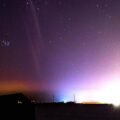Researchers studying the galaxy SPT0311-58, which is over 12.8 billion light years away, say they have found signs of water. The finding is significant because it shows that water was present less than a billion years after the universe was first formed. Exobiologists believe that water is likely a key ingredient for the evolution of extraterrestrial life.
BACKGROUND: A GALAXY FAR, FAR AWAY
First discovered in 2017 by the Atacama Large Millimeter/submillimeter Array in Chile, the far away galaxy was formed almost 13 billion years ago, or a mere 780 million years after the Big Bang.
“This galaxy is the most massive galaxy currently known at high redshift, or the time when the universe was still very young,” said Sreevani Jarugula, a University of Illinois at Urbana-Champaign astronomer and the project’s lead investigator. “It has more gas and dust compared to other galaxies in the early universe, which gives us plenty of potential opportunities to observe abundant molecules and to better understand how these life-creating elements impacted the development of the early universe.”
ANALYSIS: WE HAVE FOUND WATER!
When analyzing the light spectra of the galaxy, Jarugual says they spotted the undeniable chemical signature of water. This, he says, is a critical discovery in the search for extraterrestrial life throughout the universe, but also shows that stars were forming and dying at a much faster rate in the early universe than previously predicted.
That’s because, to make water, both Hydrogen and Oxygen are needed. Hydrogen was most likely developed during the Big Bang, but oxygen is only created by dying stars. Until now, astronomers believed most stars live for billions of years, but these results show that stars in this distant galaxy went through an entire life cycle in less than a billion years.
“Early galaxies are forming stars at a rate thousands of times that of the Milky Way,” said Jarugula. “Studying the gas and dust content of these early galaxies informs us of their properties, such as how many stars are being formed, the rate at which gas is converted into stars, how galaxies interact with each other and with the interstellar medium, and more.”
OUTLOOK: INFORMING THE SEARCH FOR EXTRATERRESTRIAL LIFE
Along with the signs of water, Jarugula says his team also detected carbon dioxide in the distant galaxy. Like oxygen, carbon is a key signature in the hunt for E.T., and Jarugula says, its presence is “critical to life.”
“These molecules, important to life on Earth, are forming as soon as they can,” said Joe Pesce, an astrophysicist and director at the National Science Foundation in a piece by USA Today, “and their observation is giving us insight into the fundamental processes of a universe very much different from today’s.”
Follow and connect with author Christopher Plain on Twitter: @plain_fiction
